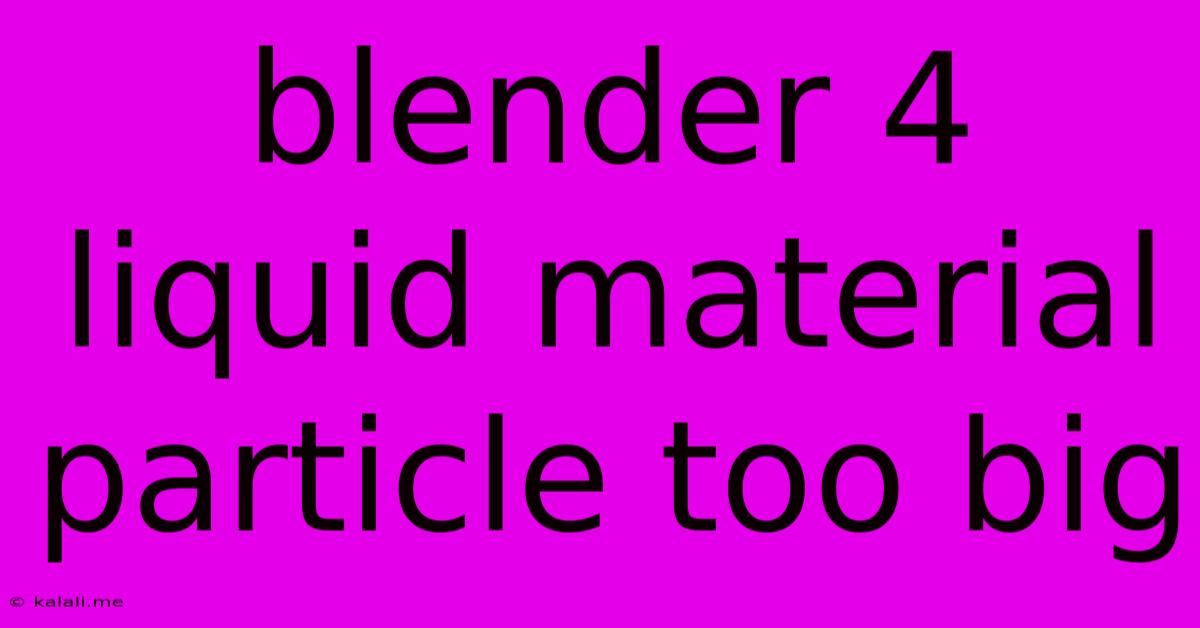Blender 4 Liquid Material Particle Too Big
Kalali
May 23, 2025 · 3 min read

Table of Contents
Blender 4: Tackling Oversized Liquid Particle Simulations
Are you finding your liquid simulations in Blender 4 resulting in particles that are far too large, ruining the realism of your renders? This is a common issue, often stemming from incorrect settings within the fluid simulation parameters. This article will guide you through troubleshooting and resolving this problem, helping you achieve the smooth, detailed liquid effects you desire. We'll cover identifying the root causes and offering practical solutions to refine your particle size for more realistic simulations.
Understanding the Source of Large Particles
Several factors contribute to oversized liquid particles in Blender's fluid simulation system. Let's break down the most common culprits:
-
Resolution: The most influential factor. A low resolution results in fewer, larger particles. Increasing the resolution dramatically increases the number of particles, creating a smoother, more detailed simulation but also significantly increasing render times. Experiment with higher resolution values within the Domain settings.
-
Scale: The size of your domain object directly impacts particle size. A larger domain will require more particles to maintain the same level of detail, potentially leading to perceived larger particles if the resolution remains unchanged. Ensure your domain is appropriately scaled to your scene.
-
Mesh Resolution: The resolution of your mesh affects how the fluid interacts with it. A low-resolution mesh might produce inaccurate flow and thus, larger appearing particles. A high-resolution mesh provides more accurate interactions, leading to better flow and smaller, more realistic particles.
Troubleshooting and Solutions
Here's a step-by-step guide to refine your liquid simulations and achieve the desired particle size:
-
Check Domain Resolution: Navigate to the Fluid Simulation properties of your domain object. The crucial setting here is Resolution. Experiment by gradually increasing the X, Y, and Z values. Higher resolution values mean smaller particles and more detailed simulations. Be aware that this greatly increases render times. Start with modest increases and observe the impact.
-
Adjust Domain Scale: If your domain is disproportionately large compared to the overall scene, this can lead to the perception of larger particles. Scale your domain down proportionally. This often solves issues where the particles seem too big relative to other scene elements.
-
Refine Mesh: If you're using a mesh as an obstacle for your fluid, ensure its resolution is sufficient. A low-poly mesh can create artifacts and inaccurate fluid interactions, potentially making particles appear larger or behave oddly. Consider increasing the polygon count of your mesh for more accurate simulation.
-
Particle Size: While not directly controlling individual particle size, the Diffusion setting indirectly affects it. Lower diffusion values can lead to slightly sharper, more defined particle boundaries, which can improve the visual appearance of the particle size.
Optimization for Performance
Increasing resolution significantly increases render time. To optimize performance, consider these strategies:
-
Subdivision Surface Modifier: Use a Subdivision Surface modifier on your mesh obstacles instead of relying solely on high-poly meshes. This provides similar detail at a lower polygon cost.
-
Cache Simulation: Use Blender's cache features to store the fluid simulation data. This will dramatically speed up subsequent renders and edits.
-
Adaptive Domain: Consider using an adaptive domain for even greater performance improvements, particularly in simulations with complex geometry.
Conclusion
Achieving the perfect liquid simulation involves balancing visual fidelity and render performance. By carefully adjusting the resolution, scaling, mesh detail and using optimization techniques, you can overcome the issue of oversized particles in your Blender 4 liquid simulations and create stunning, realistic results. Remember that experimentation and iteration are key to mastering this process. Don't be afraid to try different settings and observe their effects to find the optimal balance for your specific project.
Latest Posts
Latest Posts
-
Blender Weird Face Showing Up When Not In Edit Mode
May 23, 2025
-
How Long Is A 1 Hour Walk Through A Jungle
May 23, 2025
-
What Are Books And Movies Considered
May 23, 2025
-
No Reply Please Confirm To Continue Spoof
May 23, 2025
-
Google Sheet Script Pass Sheet To Function
May 23, 2025
Related Post
Thank you for visiting our website which covers about Blender 4 Liquid Material Particle Too Big . We hope the information provided has been useful to you. Feel free to contact us if you have any questions or need further assistance. See you next time and don't miss to bookmark.